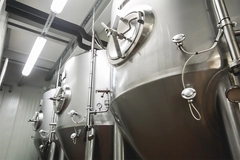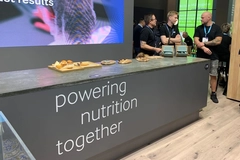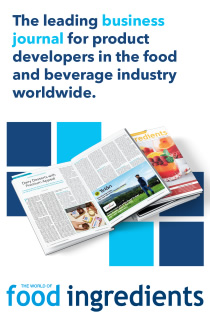
- Industry news
Industry news
- Category news
Category news
- Reports
- Key trends
- Multimedia
- Journal
- Events
- Suppliers
- Home
- Industry news
Industry news
- Category news
Category news
- Reports
- Key trends
- Multimedia
- Events
- Suppliers
The “future of alt-meat industry”: Scientists use metamaterials and injection molding to create whole cuts
Scientists in Israel and Palestine have leveraged material science to develop meat analogs that mimic the intricate architecture of muscle and fat. Their innovation comes amid escalating global meat demands that are intensifying ecological concerns and pushing food companies to look for sustainable meat alternatives.
The team used injection molding — a technique typically used in the aerospace industry — to create whole cuts of meat, which constitute 54% of the global market, but face challenges due to the lack of scalable technology.
Injection molding is a cost-effective and scalable production method that “surpasses 3D-printing technology,” according to the team at Hebrew University of Jerusalem, which conducted the study.
“The only technology we have today to create the complex structure of whole meat cuts is 3D-printing. However, the process is not scalable,” the study’s lead author Prof. Yaakov Nahmias tells Food Ingredients First.
“It requires the slow deposition of one muscle fiber after another, with a machine step on the submillimeter scale. This leads to high equipment attrition and prohibitive operating costs.”
“In contrast, injection molding is a massively scalable technology, reaching US$360 billion in 2019. With a submillimeter resolution of modern injection molding, it means that almost any type of meat cut could be generated in a cost-efficient manner from steaks or lobster tails,” he explains.
.jpeg) The low-temperature meat analogue and proteoleogel can create complex meat cuts, such as chops, steaks and T-bones (Image credit: Hebrew University). The study’s findings are published in Nature Communications.
The low-temperature meat analogue and proteoleogel can create complex meat cuts, such as chops, steaks and T-bones (Image credit: Hebrew University). The study’s findings are published in Nature Communications.
Emulating meat structure and cooking behavior
The team has developed two novel metamaterials, which are composite materials whose properties arise from their structure rather than their composition. One is a low-temperature meat analog (LTMA) that replicates the fibrous texture of muscle tissue.
The second is proteoleogel (PtoG), a plant-protein-stabilized oleogel that mimics animal fat’s structural integrity and cooking behavior.
“LTMA traps textured protein fibers semi-isotropically within a flowing gel. This creates a multi-scale material with nanoscale protein fibers embedded in microscale fascicles, that emulate the natural structure of animal muscle,” says Prof. Nahmias.
“PToG is a unique combination of protein hydrogel and oleogel emulsions creating a thermally irreversible gel that emulates the cooking of animal fat.”
These materials enable alt-meat formulators to create complex meat cuts, such as steaks, chops, and T-bones, with “remarkable precision and sensory fidelity,” states the study.
Overcoming cost and processing challenges
High moisture extrusion is the current leading approach to achieving a meat-like texture. However, Prof. Nahmias points to the method’s problem of producing layers of denatured proteins with a single size and orientation.
“This leads to a rubber-like behavior and a rapid texture breakdown upon cooking.”
.jpeg) The plant-protein-stabilized oleogel emulates the structural integrity and cooking behavior of animal fat (Image credit: Hebrew University). The team’s approach using injection molding allowed them to create complex textures by combining fibers with gels, he explains.
The plant-protein-stabilized oleogel emulates the structural integrity and cooking behavior of animal fat (Image credit: Hebrew University). The team’s approach using injection molding allowed them to create complex textures by combining fibers with gels, he explains.
Prof. Nahmias also details how the method differs from 3D-printing, another emerging technology in alt-meat production.
“Injection molding is a high-throughput method developed by James Watson Hendy in the 1940s that is already used to make over 7 billion kg of plastic products worldwide. In contrast, 3D -printing is primarily used as a rapid prototyping technology.”
“It is very difficult to envision the scale-up of 3D-printing to mass production of consumer goods, let alone commodities.”
Meanwhile, injection molding is a “highly cost-effective technology,” especially for large-scale production.
“It requires an initial investment in a reusable mold, but the process is then robust and highly automated, dramatically reducing operating costs. Even at a small scale of only 10,000 pieces of plastic injection molding would cost US$0.99 per piece compared to US$7 per piece for 3D -printing,” he explains.
Merging material science and gastronomy
Prof. Nahmias believes the study demonstrates the untapped potential of metamaterials in food technology.
 Injection molding addresses the growing global demand for meat while mitigating its environmental impact.“By harnessing their unique structural properties, we have developed a solution that is not only sustainable but also scalable, addressing the growing global demand for meat while mitigating its environmental impact.”
Injection molding addresses the growing global demand for meat while mitigating its environmental impact.“By harnessing their unique structural properties, we have developed a solution that is not only sustainable but also scalable, addressing the growing global demand for meat while mitigating its environmental impact.”
With livestock farming accounting for over 30% of global freshwater use, the scientists believe such innovations are crucial for building a sustainable food system.
Meanwhile, blind taste tests revealed the sensory appeal of the meat analogs. Participants were “seemingly unable to distinguish between steak analog and traditional meat,” notes the study.
“This milestone signifies a major step forward in consumer acceptance of sustainable protein alternatives, particularly for whole cuts, which represent over half of global meat consumption.”
“Blueprint” for future food production?
The team believes the study offers a blueprint for the future of food production.
“Metamaterials are the future of the alternative meat industry. They are cost-effective, massively scalable and outperform all existing alternatives when it comes to structure and function,” says Prof. Nahmias.
“We hope to make an announcement in one to two months on a new project in this field.”

















